Sunday 23 December, 2012, 23:02 - Radio Randomness, Satellites, Much Ado About Nothing
Posted by Administrator
It seems there are very few songs which touch on the topic of satellite communications unless you count:Posted by Administrator
- Sleeping Satellite by Tasmin Archer;
- Satellite by Lena (Germany's Eurovision winner in 2010); and
- Satellite by Oceanlab.
I'm just talking to a satellite,
Twenty thousand miles up in the sky each night
Taken from Electric Light Orchestra's Calling America.
There’s also:
I saw two shooting stars last night,
I wished on them but they were only satellites,
It's wrong to wish on space hardware.
I wish, I wish, I wish you'd care.
Taken from Kirsty Macoll's New England.
So it was nice to be alerted to a piece of work which is not only about satellites, but is very specifically endorsing the use of C-Band satellite services (3400 – 4200 MHz) over and above the use of Ku-Band (10700 – 12500 MHz) in sub-Saharan Africa where C-Band reception is more reliable than Ku-Band due to the fact that it deals with rain fading much better than Ku-Band does.
The song is by Cameroonian artist Wes. In it, he laments the loss of his Ku-band equipment, and the main thrust of the song is that he is short of some solder with which to complete the installation of his new C-Band parts. The video has him stood in front of his non-functional C-Band dish whilst his team try to dance their way into fixing the problem. Eventually they set off on a trek to try and get him some solder as the dancing, no matter how energetic, is clearly not working.
The only odd thing is that there is an Asian lady who, all the way through the song, keeps going on about her blasted spade. Still, it all adds to the ambiance.
The song is called ‘Soldery Song’, and you will need to watch the video whilst at the same time reading the lyrics below as it is quite hard to follow what he is saying due to his strong African English accent (the spade lady's incessant moaning about her spade is shown in brackets)...
SOLDERY SONG – WES
Soldery Song – Wes by jibou
(My Spade, where’s my spade?)
Soldery song: me need a solder
Me got me some parts, now it's me too,
Old part me chuck, and new me part, yeh?
Soldery song: me need me a soldery solder
Me got me some parts, now it's me too,
Old part me chuck, and me new part, yeh?
I throw a my Ku away, melt some solder, done my way
I throw a my Ku away, melt some solder, done my way
Bring us C-band way (with a spade?)
One-a-where they can go?
Hey, I meant to check.
(Spade, yeh, yeh, yeh, yeh!) x 2
Soldery song: hoo hoo hoo hoo hoo, me need a solder
Me got me some parts, now it's me too,
Old part me chuck and new me part, yeh?
I throw a my Ku away, melt some solder, done my way
I throw a my Ku away, melt some solder, done my way
Bring us C-band way (with a spade?)
One-a-where they can go?
Hey, I meant to check.
(Spade, yeh, yeh, yeh, yeh!) x 2
No more can I Ku, new me parts C-band
No more can I Ku, new me parts knackered!
No more can I Ku, new me parts C-band
No more can I Ku, new me parts knackered!
No more can I Ku, new me parts C-band
No more can I Ku, new me parts knackered!
I throw a my Ku away, melt some solder, done my way x 4
Bring us C-band way (with a spade?)
One-a-where they can go?
(Spade, yeh, yeh, yeh, yeh!)
Bring us C-band way (with a spade?)
One-a-where they can go?
Hey, I meant to check.
No more can I Ku, new me parts C-band
No more can I Ku, new me parts knackered!
No more can I Ku, new me parts C-band
No more can I Ku...
(Spade, yeh, yeh, yeh, yeh!)
Perhaps some kind Wireless Waffle reader could purchase some solder and send it to Wes to get his C-band equipment up and working. Oh, and whilst you’re at it, give the poor lady a spade too.
1 comment
( 2211 views )
| permalink
| 



 ( 2.9 / 8624 )
( 2.9 / 8624 )




 ( 2.9 / 8624 )
( 2.9 / 8624 )
 Although the standard for WiFi at 5 GHz has been around for a long time, most manufacturers have focused upon producing equipment for the 2.4 GHz band. The reason for this is a simple one - it's cheaper! The higher you go in frequency, the more difficult, and therefore expensive, it becomes to transmit and receive radio signals. As a result, home routers, laptops, smart phones and other devices have almost exclusively been equipped to use the 2.4 GHz band for their WiFi connection.
Although the standard for WiFi at 5 GHz has been around for a long time, most manufacturers have focused upon producing equipment for the 2.4 GHz band. The reason for this is a simple one - it's cheaper! The higher you go in frequency, the more difficult, and therefore expensive, it becomes to transmit and receive radio signals. As a result, home routers, laptops, smart phones and other devices have almost exclusively been equipped to use the 2.4 GHz band for their WiFi connection.Previous Wireless Waffle articles have discussed how to select the best WiFi channels in the 2.4 GHz band, and other techniques, to maximise coverage and signal quality, however we have not looked at the 5 GHz band. Recently, there seem to be a slew of articles which are claiming that using 5 GHz will produce better range and more reliable connections compared to 2.4 GHz. The logic of these articles seems to go '5 is a bigger number than 2.4 - in fact it is more than double - so it must be at least twice as good'. This, sad to say, is not the case. Here are the real facts:
- Signals at 5 GHz only travel HALF as far as those on 2.4 GHz as higher frequencies have poorer coverage than lower ones.
- Signals at 5 GHz will struggle almost TWICE AS HARD to get through walls than signals at 2.4 GHz due to their poorer propagation characteristics.
- 5 GHz WiFi equipment is subject to exactly the same POWER RESTRICTIONS as that for 2.4 GHz, so there is no inherent advantage in terms of the technology itself.
- The use of some of the 5 GHz channels is subject to the requirement to STOP TRANSMITTING if a nearby radar is detected. No such restriction applies at 2.4 GHz.
- 5 GHz equipment will be (slightly) more POWER HUNGRY than its 2.4 GHz counterparts, increasing battery drain especially in mobile devices.
- 5 GHz receivers are likely to be LESS SENSITIVE than 2.4 GHz receivers because of the increased difficulty of making low noise devices at higher frequencies.
- The 5 GHz band consists of up to 25 (territory dependent) independent channels which can be used without interfering with each other meaning there is much GREATER CAPACITY for more networks, whereas the 2.4 GHz band has 13 channels of which only 3 can be used independently.
- The 2.4 GHz band is also used for Bluetooth, microwave ovens, wireless cameras and many other applications meaning it can be subject to a lot of background interference. The 5 GHz band is MUCH CLEANER, though the band is not exclusive to WiFi systems.
- There are still fewer 5 GHz devices around than 2.4 GHz once and hence it is likely to be LESS SUSCEPTIBLE TO SNOOPING.
For a home network, in a small house or apartment, using 5 GHz may offer some advantages given the lower interference it will suffer from other devices, but in large family homes a 5 GHz WiFi router is unlikely to be able to outperform the coverage and range that a 2.4 GHz router achieves.
 Where the 5 GHz band may come into its own is when the not-quite-yet-finalised IEEE 802.11ac standard is adopted. This works in the 5 GHz bands and uses the greater capacity of the band to deliver connection speeds of up to 1 Gbps. For streaming media around, this has clear advantages. As a wireless distribution for a home internet connection, however, there is unlikely to be any improvement noticeable using 802.11ac than with the existing 802.11n standard which can already offer connections of over 100 Mbps - much faster than most home internet connections!
Where the 5 GHz band may come into its own is when the not-quite-yet-finalised IEEE 802.11ac standard is adopted. This works in the 5 GHz bands and uses the greater capacity of the band to deliver connection speeds of up to 1 Gbps. For streaming media around, this has clear advantages. As a wireless distribution for a home internet connection, however, there is unlikely to be any improvement noticeable using 802.11ac than with the existing 802.11n standard which can already offer connections of over 100 Mbps - much faster than most home internet connections!Sunday 1 April, 2012, 18:59 - Radio Randomness
Posted by Administrator
One major problem facing many authorities across the world, is the transient nature of radio transmissions. For example, tracking down a radio transmitter requires the transmitter to be active in order for its direction to be sensed. Equally, for those bodies (such as the security services) who wish to capture radio transmissions of various sorts, especially those thay may be of short duration, the only way is to place sophisticated and costly wide-bandwidth receivers in a particular location which record everything they receive onto a hard disk, the data from which has to be analysed at great expense.Posted by Administrator
How much simpler it would be, if there were a device or material of some kind which would 'capture' any radio transmission and then store it such that it could be collected at a later date. Such a device should ideally:
- require no power source to operate;
- be able to store transmissions for an indefinite period;
- be deployable and collectable by untrained agents;
- not look out of the ordinary such that it does not arouse suspicion;
- capture even the shortest burst of transmissions.
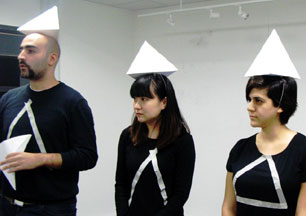
Professor Lilo and his team
It is also not necessary to actually strike the chime for it to begin resonating. If a tuning fork which produces the same tone as a chime is held next to it, the chime will 'super-resonate' with the tuning fork and begin to reproduce the tone. If a tuning fork were held next to a chime in a frictionless environment, the chime would continue to produce the tone indefinitely, long after the tuning fork were removed from the area.
Using this concept, Professor Lilo has developed the 'super-resonant frequency memocorder' (or Spereo Quemord for short). The concept is almost identical. A dipole antenna mounted in a frictionless radio environment, which is one in which no alternative electromagnetic fields can 'usurp' or 'slurp' the energy contained in the dipole (known as an 'anti-uslurp field' such as that found in certain Faraday cages) will continue to resonate and thus repeat and store any signals which excite it. The difficulty is coupling the dipole to the outside world whilst maintaining the anti-uslurp field and it is this element of the 'Spereo Quemord' which is still under wraps.
By using a number of Spereo Quemords of different but similar sizes, it is possible to store and record radio transmissions over a range of frequencies. Retrieving any signals stored is simply a case of removing the anti-uslurp field at which point the stored signals are re-radiated from the dipoles directly replicating the transmission which originally excited the Quemords.
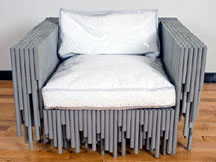 The first prototype of the device was built unobtrusively into a piece of chair-shaped lounge furniture and placed into the waiting room in the University's health centre. At the end of the day, the device was taken back to the laboratory where the elements of the device which generate the all-important anti-uslurp field were removed. The team at the University were able to recover some 2G and 3G mobile signals as well as several hours of WiFi, a number of short transmissions from a passing security van and even the lunchtime news on the local community television station, 'Travnja budale šala TV' (TBS).
The first prototype of the device was built unobtrusively into a piece of chair-shaped lounge furniture and placed into the waiting room in the University's health centre. At the end of the day, the device was taken back to the laboratory where the elements of the device which generate the all-important anti-uslurp field were removed. The team at the University were able to recover some 2G and 3G mobile signals as well as several hours of WiFi, a number of short transmissions from a passing security van and even the lunchtime news on the local community television station, 'Travnja budale šala TV' (TBS). 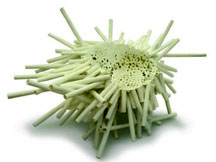 Flushed with their success, Professor Lilo and his colleagues have gone on to build a piece of furniture made exclusively of Spereo Quemords which they have used to demonstrate its capabilities at various venues. Their greatest achievement to date was to record and reproduce very weak signals from GPS satellites causing all the GPS devices in the room to show their position as being that where the device was originally located (and where it recorded the signals) and not in the room in which it was being demonstrated!
Flushed with their success, Professor Lilo and his colleagues have gone on to build a piece of furniture made exclusively of Spereo Quemords which they have used to demonstrate its capabilities at various venues. Their greatest achievement to date was to record and reproduce very weak signals from GPS satellites causing all the GPS devices in the room to show their position as being that where the device was originally located (and where it recorded the signals) and not in the room in which it was being demonstrated!The next stage is to attempt to reduce the size of the Quemords which Professor Lilo believes will be possible using room-temperature super-conductors which will allow the dipoles and the anti-uslurp field generators to be made almost infinitely small. They believe that it should be possible to develop a device which records and stores all transmissions on all frequencies in a unit no larger than a typical mobile phone, or small piece of fruit.
As always, Wireless Waffle likes to keep you up to date with the latest developments in radio technology. Rest assured that as soon as there is any further news on this exciting piece of radio technology, you will here about it here first.
Monday 27 February, 2012, 14:13 - Radio Randomness
Posted by Administrator
Regular readers of Wireless Waffle will be familiar with our relentless drive to improve both the availability, performance and aesthetics of antennas that can be used to listen to radio signals in situations where normal aerials are not feasible.Posted by Administrator
The Wireless Waffle Super Signal Holiday HF Antenna Apparel (WWSSHHFAA), a cunning aerial designed to go almost unnoticed on the wearer (though anecdotal evidence suggests that it does cause the wearer to become highly noticeable) which we updated in 2010, is one such solution. Whilst there are many examples of the WWSSHHFAA on beaches across the beaches of the Mediterranean, we have yet to receive an offer from anyone wishing to put it into full commercial production.
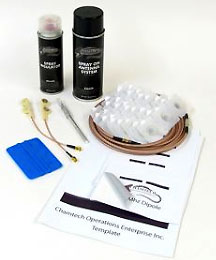 We were surprised, therefore, to recieve a tip-off about an antenna that, in principle, can surpass the performance of even the WWSSHHFAA in quality of reception, in its ease of application, and its resulting aesthetic manifestation... Go and take a look at the Spray-On Antenna!
We were surprised, therefore, to recieve a tip-off about an antenna that, in principle, can surpass the performance of even the WWSSHHFAA in quality of reception, in its ease of application, and its resulting aesthetic manifestation... Go and take a look at the Spray-On Antenna! The Spray-On Antenna is, in essence, a metallised spray which coats whatever it is sprayed on with... metal. As metal conducts electricity, it can, of course act as an antenna. Thus by spraying any everyday thing with metal paint it will become an antenna. If the resulting metallised object is connected directly to the transmitter (the tools for which appear to be provided with the spray-on antenna kit) it can be used as an antenna. If it isn't it can still be useful as a reflector. A reflector on an antenna is just like a reflector on a flashlight or car headlight, it refocuses emissions that would otherwise have been heading out in the wrong direction and points them in the right direction. Putting a reflector behind a transmitting antenna therefore focuses power in the opposite direction. How effective it is depends on a number of important factors such as:
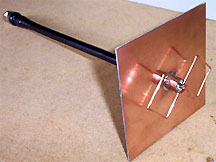
- The relationship between the size of the object that has been sprayed and the wavelength of the frequency being used - ideally the two would be harmonically related, or at least the antenna/reflector would be larger in wavelength than the frequency being used.
- The distance between the reflector and the transmitting antenna (if used as a reflector instead of an antenna).
- The specific shape of the antenna or reflector. For antennas, a line (like a wire) is good. For a reflector, parabols are good (as with satellite dishes), flat panels can work (see picture), otherwise a thin line will work as long as it is the same polarisation as the transmitting aerial.
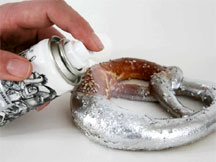 So just about any object could be used to enhance reception. On the left here is a 'pretzeltennna'. The pretzeltenna, if placed at exactly the right distance behind, for example, a cell-phone could act as a reflector and boost signals in one direction. Alternatively two pretzeltennas could be used to form a 'dipretzel', centre-fed with coax cable. The advantage of a dipretzel is that, if you get hungty, you can feed yourself with it too (though the metal spray might poison you).
So just about any object could be used to enhance reception. On the left here is a 'pretzeltennna'. The pretzeltenna, if placed at exactly the right distance behind, for example, a cell-phone could act as a reflector and boost signals in one direction. Alternatively two pretzeltennas could be used to form a 'dipretzel', centre-fed with coax cable. The advantage of a dipretzel is that, if you get hungty, you can feed yourself with it too (though the metal spray might poison you).For those on holiday with no way of stringing up antennas (the problem that the original WWSSHHFAA was designed to overcome), the concept of using a spray-on antenna provides a new and interesting way ahead. A comparison of the two solutions is shown below. On the left, the original WWSSHHFAA, with hidden wires acting as an antenna stretched across the supporting structure. On the right, a spray-on antenna on a similar supporting structure. We have been unable to test the spray-on antenna in this configuration, though we would expect that it would significantly enhance reception given its larger conductive surface area.
 |
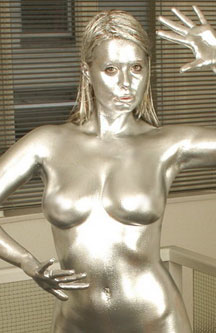 |
| Original Wireless Waffle Holiday HF Antenna Apparel | Similar supporting structure with Spray-On Antenna |
Post Script: We have received a message from Timothy Matthews from Polzeath, Cornwall. Timothy writes,
"I got, like, a can of spray-on antenna from, like, a local 'craft' shop and zizzed it on a few 's'pportin' structures'. I tried, like, tappin' in to the structures to extend my 'antenna' but all I 'received' was an extension to my overdraft, large, innit."
Well, Timothy, any kind of antenna of this type requires very delicate adjustment and we recommend that in the future, you 'leperately twelt them over the hish with a squench' as admirably described on the ropium web-site which is full of useless tips which make about as much sense as your e-mail.

